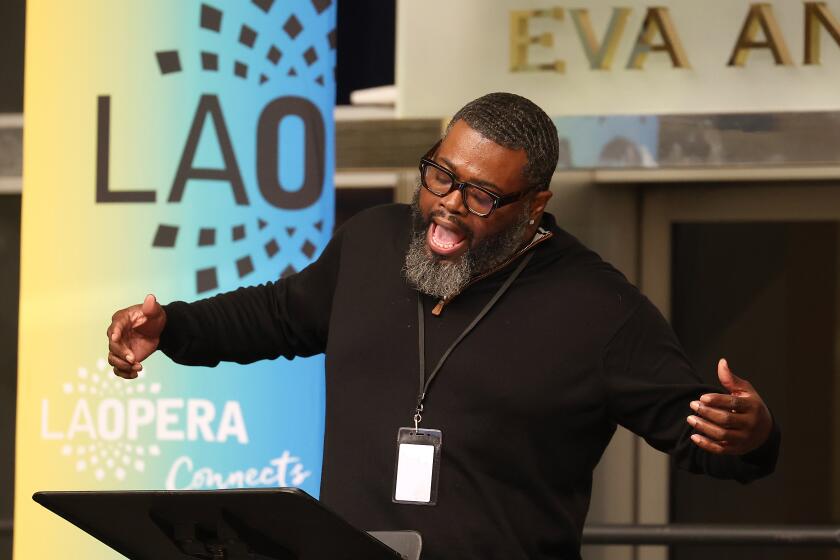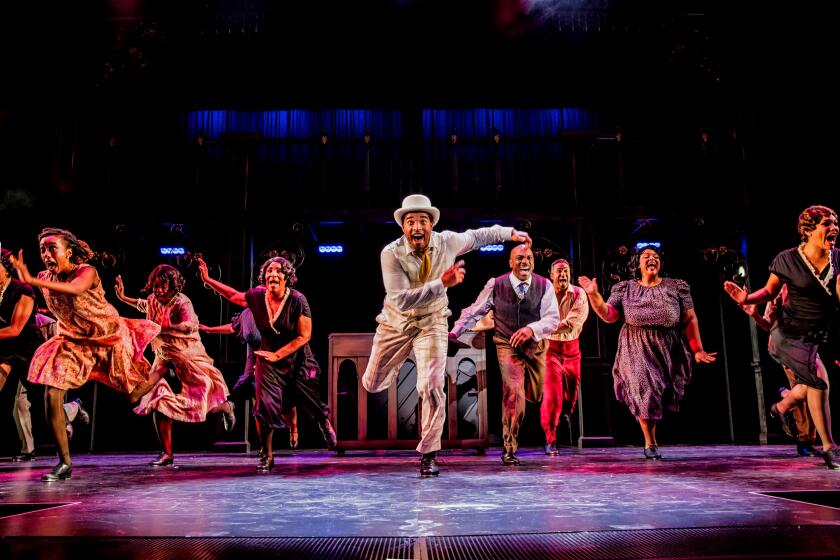The Challenge Facing Mexican Philharmonic
Juggling a tight schedule of rehearsals, administrative duties and a quick trip to replace his just-stolen passport, Luis Herrera de la Fuente keeps a fast pace. The artistic director and conductor of the Mexico City Philharmonic Orchestra has big plans for his group of musicians, and his round-the-clock efforts are paying off.
Times are good for the 14-year-old Philharmonic, regarded by many as the foremost orchestra in Mexico, which makes its Hollywood Bowl debut tonight and will also play Thursday.
“Many Mexican orchestras have often traveled to the United States and elsewhere, but this trip has special significance because we are going by invitation of the Los Angeles Philharmonic,” said the maestro, his enthusiasm overtaking an otherwise serious manner. The 76-year-old conductor added: “This gives us a special distinction because they have asked us over every other Mexican orchestra. This is very satisfying.”
Even though there has been little awareness of Mexican symphonic music outside Latin America, the genre is alive and well, especially considering that back home, the Philharmonic is just one of three major orchestras in the country’s capital city. The government’s official National Symphony Orchestra and the National Autonomous University of Mexico’s orchestra also keep busy agendas in a flourishing symphonic culture.
There have been highs and lows in the orchestras’ histories, however. Because all three are government funded, the rocky marriage between politics and the arts has routinely prompted setbacks in the flow of their artistic development.
*
The complete overhaul of political appointments in each presidential administration brings cyclical changes in the administration of the arts as well. This usually means the replacement of artistic directors in all three orchestras every six years; a symphony just reaching its peak may suddenly hit bottom under a new conductor.
The Philharmonic was founded in 1978 under the guidance of Carmen Romano de Lopez Portillo, wife of former President Jose Lopez Portillo. While the Philharmonic receives government financial support, it is attempting to develop private funding sources as well as maintain some administrative autonomy.
“The support of cultural projects depends on who is in the government and on their political decisions,” said music critic Pablo Espinosa. For this reason, Mexico’s orchestras have had little opportunity to sustain continued development.
The prestigious National Symphony has been particularly hard hit. “This orchestra has suffered the most,” Espinosa said. “The director is named by political authorities. Currently, they have a good director, but nobody can guarantee what will happen.”
Labor union problems have also taken their toll; the orchestra must hold regular auditions to fill vacancies stemming from wage disputes. It continues to be buoyed, however, by its tradition and prestige as the country’s first established orchestra, dating to 1928.
“The National Symphony Orchestra is immersed in bureaucracy. But it is not a disaster. It is the second best orchestra in the country,” Espinosa said.
While they lick old wounds, the arts in Mexico must owe their survival to those same political instruments that finance their projects. “Mexico is one of the few countries (in Latin America) where art receives strong financial backing and is permitted to develop,” said Aurelio Tello, sub-director of the government’s National Music and Opera Council.
“Even during the economic crisis of the early ‘80s, the government did not stop supporting the arts; the cultural life of Mexico was kept alive.”
*
It was during an earlier crisis that Herrera, then director of the National Symphony, left Mexico and continued his long career with various foreign orchestras, among them the national symphonies of Chile and Peru, and the Oklahoma Symphony.
Now, Herrera is back in Mexico as head of the Philharmonic, but with strings attached. Just over two years ago he accepted the post, but on one condition: He must have the political support to make his own artistic decisions, and to allow the institution to operate autonomously and free of political and financial impositions. The mayor’s office, which has traditionally administered the Philharmonic, agreed.
With a healthy budget and the new development of private funding sources, the orchestra currently offers the best musicians’ salaries in the country. The Philharmonic is considered stronger and more artistically focused under Herrera’s leadership. Meanwhile, the National Symphony Orchestra, under directorship of Enrique Diemecke, is in a process of reconsolidation and recently completed a five-performance tour of Spain and Portugal.
There is apparently no major rivalry between the city’s orchestras. The sheer size of Mexico City, with 19 million people, can sustain them. The orchestras are geographically dispersed: The Philharmonic plays in the south of the metropolis; the National Symphony caters to the city’s downtown. The UNAM orchestra is frequented mostly by students.
Symphony tickets are inexpensive, but attendance to events is uneven. Audience size depends on which works are being performed or if there is a special guest artist. The public responds best to the popular classics. “For example, when Beethoven’s Ninth Symphony is performed, people show up in droves and fill the hall to capacity,” observed Tello. However, he notes an increased interest in Mexican music in the last decade.
Tonight in Los Angeles, the Philharmonic will perform a program of European work, including Beethoven’s Piano Concerto No. 3. Thursday, the program includes a variety of Mexican music that is much less familiar to Americans than the popular sounds of mariachi, ranchero and folklorico .
Herrera has been criticized for relying heavily on the classics and not promoting enough new Mexican works.
“Unfortunately, he tends to be limited. He always repeats the same works and the same composers,” said music critic Jose Antonio Alcaraz. “He has an enormous dexterity and grasp of material. He is such a complete musician, one would like to see him pushing things forward.”
Herrera is unruffled by such comments and, in his gentlemanly way, is inclined to agree.
“This is a phenomenon that occurs all over the world. The critics in the U.S. say their orchestras do not play enough modern American music. The same type of thing happens in Berlin, in Paris, in Mexico. And they are right.”
He then is quick to defend his programming policy as an attempt to strike a fine balance. He must appeal to public tastes as well as the box office, even as he reaches artistically. He laments that there simply are not as many contemporary choices compared to the wealth of ancient offerings. “The Mexican press says I am stubborn and impose restrictions. Well, at least I agree with those who criticize that there is not enough new music.”
These days, though, public opinion is largely in favor of the hard-working and talented director. Critic Espinosa claims that the Philharmonic is the best orchestra in Mexico primarily because the venerable Herrera is at the helm.
“The orchestra has a musical quality that comes from the podium. In the last 20 months, the Philharmonic has really developed its sound,” he said. “Before, it was a good orchestra, but it did not have direction. Now, it has a personal artistic conception, because it has Herrera de la Fuente.”
Music lovers are finding hope in the current success of the Mexico City Philharmonic. But will the city-sponsored orchestra survive the next change of the country’s administration, when even the mayor will be replaced?
Herrera laughs. “I just cross my fingers,” he said. “I am a skeptical optimist. I take nothing for granted. Things do not just happen, you have to fight for them.”
More to Read
More to Read
More to Read
The biggest entertainment stories
Get our big stories about Hollywood, film, television, music, arts, culture and more right in your inbox as soon as they publish.
You may occasionally receive promotional content from the Los Angeles Times.






